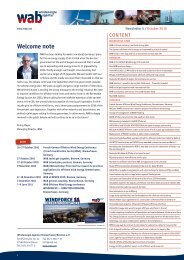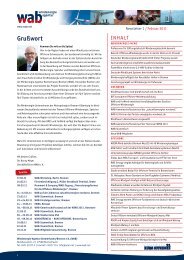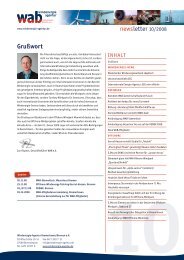Wind Energy
Wind Energy
Wind Energy
Create successful ePaper yourself
Turn your PDF publications into a flip-book with our unique Google optimized e-Paper software.
OffshOre #2 | The Magazine<br />
a sOlId fInancIal basIs<br />
The offshore industry in Germany can rely on a high feed-in tariff and a stable political framework.<br />
The amended Renewable <strong>Energy</strong> Sources Act (EEG), which came<br />
into force in Germany on 1 January 2009, increased the feed-in tariff<br />
for offshore wind power. The act ensures that all turbines put into<br />
service before 1 January 2016 receive 15 euro cents per kWh of windgenerated<br />
electricity. This rate is valid for a period of 12 years for all<br />
turbines. To promote the construction of wind farms that need to be<br />
built even further offshore and in even deeper waters, the basic feedin<br />
tariff is supplemented by an extension of the period of payment.<br />
Turbines located more than 12 nautical miles from the coast in waters<br />
at least 20 metres deep benefit from an extension of half a month’s<br />
payment for every full nautical mile additional distance from shore,<br />
and an extension of 1.7 months for every additional metre of water<br />
depth. For example, a wind turbine sited 30 nautical miles from the<br />
nearest shore in water 40 metres deep receives a feed-in tariff of 15<br />
euro cents per kWh for 18.7 years. Hence the payment period for<br />
most German offshore wind farms is in the region of 20 years, which<br />
puts them on an equal footing with the onshore wind industry.<br />
The tariff per kWh falls by five percent per year starting from 2015.<br />
32<br />
Alongside the calculable, fixed feed-in tariff, a second line of support<br />
in Germany is provided by an act to accelerate infrastructure planning.<br />
This Infrastructure Planning Acceleration Act enshrines in law that the<br />
power grid operators transpower stromübertragungs gmbh (former E.ON<br />
Netz) for the North Sea and Vattenfall Europe Baltic Offshore Grid GmbH<br />
(VE BOG) for the Baltic are to construct the power grid for the offshore<br />
wind farms at the request of the wind farm operators – so-called power<br />
points at sea. As a result, operators should save between one-fifth to<br />
one-third of total investment costs.<br />
Basic remuneration 12 * 12 = 144 months<br />
Distance supplement (30 sm -12 sm) * 0.5 = 9 months<br />
Depth supplement (40 m -20 m) * 1.7 = 34 months<br />
187 / 15.6 months / years<br />
Period in which feed-in tariff is paid for an offshore wind turbine<br />
30 nautical miles from the coast in waters 40 metres deep








